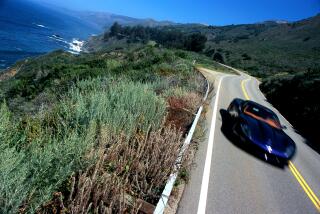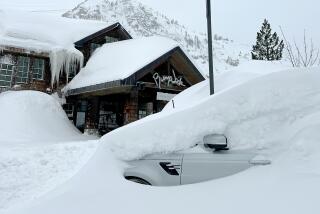Where There’s Ice, There Ought to Be Chains
- Share via
Southern Californians are generally more adept at roller-blading than driving in the snow, particularly when it comes to negotiating the icy mountain roads around Big Bear or in the Sierra Nevada.
Taking on treacherous winter roads in the mountains almost always calls for a set of tire chains, not only as a matter of common sense but also because law enforcement typically requires them when snow starts to fall.
But many owners of late-model vehicles are discovering that their cars--even some sport-utility vehicles--are not designed with enough clearance in the wheel wells to handle most tire chains.
Reader D.W. of Mission Viejo informed Your Wheels recently about such a problem with his all-wheel-drive Subaru Outback wagon. A hiking trip up Mt. San Gorgonio was cut short after he found out that his Outback could not handle tire chains.
“It’s ridiculous,” he complained. “Subaru ads show the Outback in the snow.”
The Outback is not the only vehicle that can’t take chains. Even the big Lincoln Navigator and Jeep Grand Cherokee SUVs have clearance problems, according to Quality Chain Corp., a major supplier to the Southern California market.
A number of passenger sedans are in the same boat. The Buick LeSabre, Cadillac DeVille, Chevrolet Malibu and Chrysler Concorde, among many others, have trouble accommodating chains.
The problem arises when the wheels fit so closely to the fenders that there simply is not enough space for chains on the tires of some of these vehicles, says Rick Schmunck, president of Quality Chain of Hillsboro, Ore. If you try to jam in a chain, you could end up causing serious body damage.
As important as tire chains are to safe driving in icy mountains, auto makers typically will not certify their vehicles as being able to use them.
Indeed, Subaru representatives say the Outback was not designed with chains in mind.
“We haven’t tested tire chains on that car yet, so we can’t recommend using them at this time,” Subaru spokesman Rob Moran said.
Moran said the owner’s manuals specifically note that some Subarus cannot handle chains. That shortcoming has caused some owners to howl.
But Mike Wheelan, a Subaru product spokesman, says that Outback owners never need chains. “Our all-wheel-drive systems are so good in the snow that chains are not a requirement,” he said.
Try telling that to police or Highway Patrol officers at a chain checkpoint in the mountains. In some conditions, California authorities require chains even on four-wheel-drive vehicles.
*
The auto industry generally treats tire chains as a home remedy for the problem of icy roads. Chains are not certified to any safety standards set by the National Highway Traffic Safety Administration; the agency’s Web site contains no information about tire chains.
Not surprisingly, the chains come in a variety of forms. The garden-variety cable chains sold at most auto-parts stores for $30 to $50 will last only 150 miles, and that assumes they are correctly installed. Better-quality chains will go for up to 1,000 miles, Schmunck says.
Even more durable products are available but at a much higher cost. One Quality Chain product, called Spiked Spider and priced at $315, is designed to fit many models that can’t handle regular chains.
They are so easy to install, Schmunck said, that “you could do it in high heels in two minutes and you won’t get dirty.” They are available on Quality Chain’s Web site, https://www.chainquest.com, and through other distributors.
Tire chains must be carefully installed. In many cases, improperly installed chains can shake loose, causing body damage or even compromising a vehicle’s traction.
Some motorists try to sneak past safety checkpoints in the mountains because they don’t have chains. They may think they are invincible behind the wheel of a huge SUV or other four-wheel-drive vehicle.
But without proper traction on a snow- or ice-covered mountain road, you put yourself at great peril. The risk of spinning out on a patch of ice or losing control coming down the mountain is just too great.
For owners of two-wheel-drive cars that won’t accommodate chains, it might be best to avoid the snowy high country altogether in wintertime.
*
Jeanne Wright cannot answer mail personally but responds in this column to automotive questions of general interest. Write to Your Wheels, Business Section, Los Angeles Times, 202 W. 1st St., Los Angeles, CA 90012. E-mail: jeanrite@aol.com.






